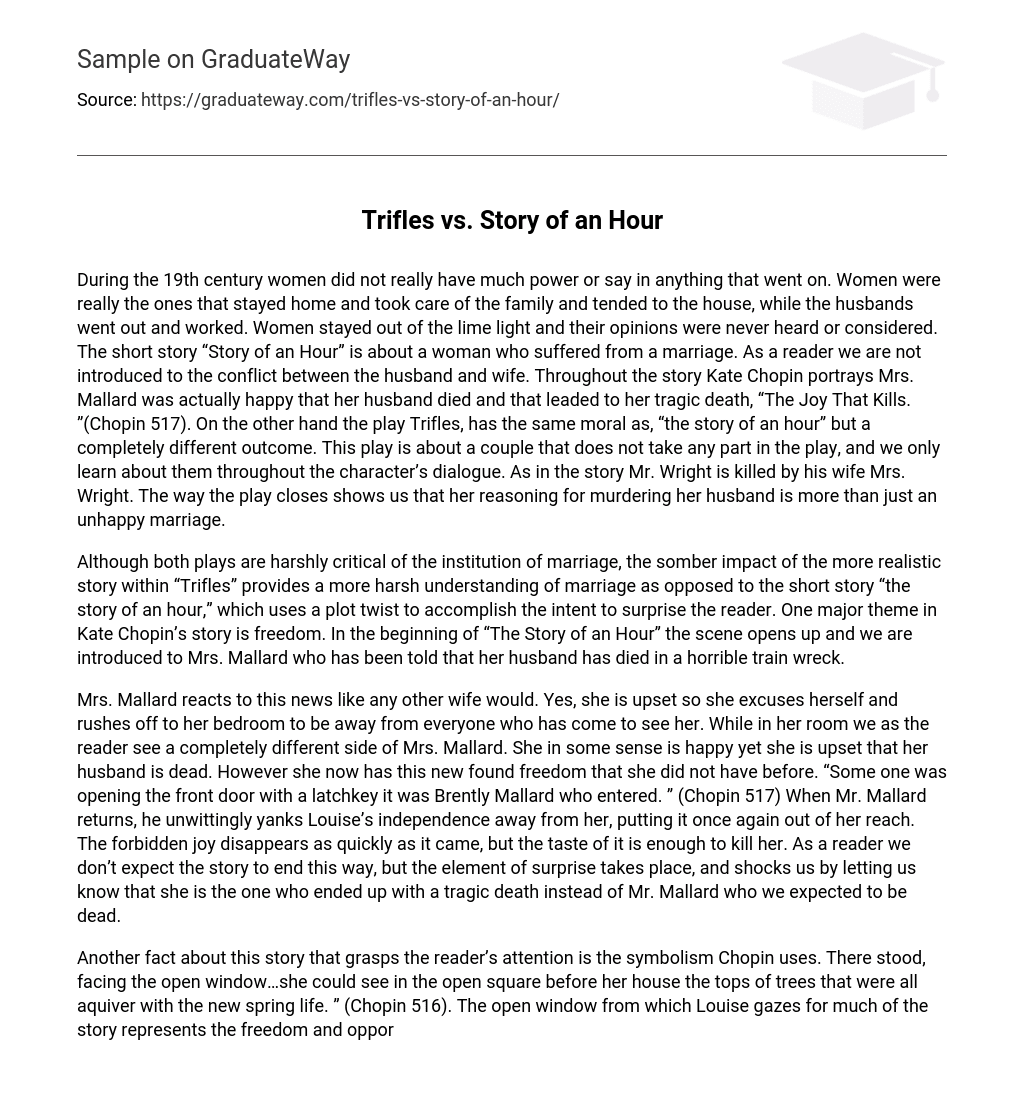During the 19th century women did not really have much power or say in anything that went on. Women were really the ones that stayed home and took care of the family and tended to the house, while the husbands went out and worked. Women stayed out of the lime light and their opinions were never heard or considered. The short story “Story of an Hour” is about a woman who suffered from a marriage. As a reader we are not introduced to the conflict between the husband and wife. Throughout the story Kate Chopin portrays Mrs. Mallard was actually happy that her husband died and that leaded to her tragic death, “The Joy That Kills. ”(Chopin 517). On the other hand the play Trifles, has the same moral as, “the story of an hour” but a completely different outcome. This play is about a couple that does not take any part in the play, and we only learn about them throughout the character’s dialogue. As in the story Mr. Wright is killed by his wife Mrs. Wright. The way the play closes shows us that her reasoning for murdering her husband is more than just an unhappy marriage.
Although both plays are harshly critical of the institution of marriage, the somber impact of the more realistic story within “Trifles” provides a more harsh understanding of marriage as opposed to the short story “the story of an hour,” which uses a plot twist to accomplish the intent to surprise the reader. One major theme in Kate Chopin’s story is freedom. In the beginning of “The Story of an Hour” the scene opens up and we are introduced to Mrs. Mallard who has been told that her husband has died in a horrible train wreck.
Mrs. Mallard reacts to this news like any other wife would. Yes, she is upset so she excuses herself and rushes off to her bedroom to be away from everyone who has come to see her. While in her room we as the reader see a completely different side of Mrs. Mallard. She in some sense is happy yet she is upset that her husband is dead. However she now has this new found freedom that she did not have before. “Some one was opening the front door with a latchkey it was Brently Mallard who entered. ” (Chopin 517) When Mr. Mallard returns, he unwittingly yanks Louise’s independence away from her, putting it once again out of her reach. The forbidden joy disappears as quickly as it came, but the taste of it is enough to kill her. As a reader we don’t expect the story to end this way, but the element of surprise takes place, and shocks us by letting us know that she is the one who ended up with a tragic death instead of Mr. Mallard who we expected to be dead.
Another fact about this story that grasps the reader’s attention is the symbolism Chopin uses. There stood, facing the open window…she could see in the open square before her house the tops of trees that were all aquiver with the new spring life. ” (Chopin 516). The open window from which Louise gazes for much of the story represents the freedom and opportunities that await her after her husband has died. In the short story “The Story of an Hour” we are introduced to the characters. The author takes us to the main character’s thoughts and that is where the reader is introduced to the conflict.
Unlike the short story “The Story of an Hour,” “Trifles” isn’t directly about marriage; the topic of marriage is subtly hinted at by devices in the dialogue and setting rather than overtly flaunted by the characters’ mannerisms. In the play trifles the main characters don’t participate in the play. The audience learns about Mrs. Wright as they see Mrs. Peters and Mrs. Hale going through her house, and the objects that they find during the investigation. The pans under the sink are unwashed, there’s a loaf of bread sitting out, and things around the house are unfinished.
The disorder of Mrs. Wright’s housework seems to indicate disorder in her life. Also, the women find a broken birdcage and Mrs. Wright’s dead bird in her sewing basket. MRS. PETERS. Somebody-wrung-its-neck. (1118) The bird’s neck had been wrung, and Mrs. Hale believes that Mr. Wright did it. The bird was beloved by Mrs. Wright. If Mr. Wright did indeed wring the bird’s neck, it could be an indication of abuse. The bird can be considered a symbol of Mrs. Wright herself; indeed, Mrs. Hale refers to her as a “songbird” early in the play. Mr. Wright’s murder of the bird thus suggests suffocation of Mrs. Wright socially and mentally as well. The bird’s murder motivates Mrs. Wright to kill her husband and confirms that their marriage was a failed one. In the beginning of the play the audience is shown that the murderer of Mr. Wright is his wife and by end of the play the audience’s perspective changes as in why Mrs. Wright killed her husband. The play shows a great picture of lack of power of woman during that time because Mrs. Hale and Mrs. Peterson found evidence but throughout the plot they were both being ignored.
Through the dialogue, we learn of the serious trials of marriage that women had to endure, the problems are true to life and utterly believable, and the dialogue has a heavy emotional impact. Its somber tone, realistic subject matter, heavy symbolism and believable characters make “Trifles” a more scathing indictment of marriage than “The Story of an Hour. ” The heavy emotional impact left by the former is more likely to leave an audience thinking about the problems in marriage than will implement a light-hearted tragedy about the couple in “The Story of an Hour. ”





